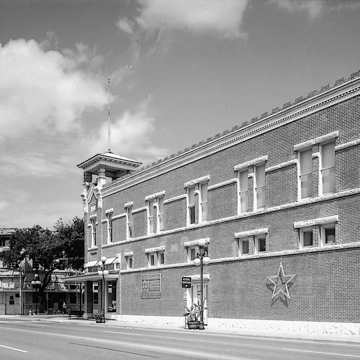This architectural beacon guards the western entrance to downtown. Both its grand design and influential owners, including Kleberg and Flato as partners, guaranteed the success of the “Raglands” (the store's popular name) as the leading dry goods and clothing store in Kingsville. The two-part commercial block, in outdated late-nineteenth-century vocabulary by its time of construction, underwent a curious reincarnation in 1950 as King Ranch, Inc., its sole owner since 1940, brought in family friend and noted industrial designer Raymond Loewy to usher the Rag-lands into the modern era. Loewy turned the ground floor into a sleek, totally transparent sales space, and sheathed the upper stories in metal panels punctured with a dotted grid pattern. After its closure in 1979, the King family rehabilitated the building as an elegant saddle shop in 1989. Chronicling the tension between preservation and modernity in the twentieth century, the store was brought back to its original 1909 Leffland design in the new rehabilitation effort, with none of Loewy's modernist features left standing.
You are here
John B. Ragland Mercantile Company Building
If SAH Archipedia has been useful to you, please consider supporting it.
SAH Archipedia tells the story of the United States through its buildings, landscapes, and cities. This freely available resource empowers the public with authoritative knowledge that deepens their understanding and appreciation of the built environment. But the Society of Architectural Historians, which created SAH Archipedia with University of Virginia Press, needs your support to maintain the high-caliber research, writing, photography, cartography, editing, design, and programming that make SAH Archipedia a trusted online resource available to all who value the history of place, heritage tourism, and learning.















